Business Law Assignment: Analysis of ASIC v Citigroup Case Decision
VerifiedAdded on 2020/05/28
|11
|2857
|109
Case Study
AI Summary
This case analysis examines the Australian Securities and Investments Commission v Citigroup Global Markets Australia Pty Limited [2007] FCA 963 case, focusing on the allegations of insider trading and breaches of director duties under the Corporations Act 2001 (Cth). The case involved Citigroup's equities trading and investment banking divisions and the implementation of Chinese Walls to prevent information flow. ASIC alleged contraventions of section 912(1)(aa) and other sections of the Corporations Act and the ASIC Act. The court found that Citigroup had not breached any laws, emphasizing the absence of a fiduciary relationship in the absence of specific contractual terms and the effectiveness of the Chinese Walls. The court's decision highlighted the importance of compliance systems and the proper application of Chinese Walls to avoid allegations of insider trading and protect companies from legal liabilities. The case serves as a crucial study for business law students.
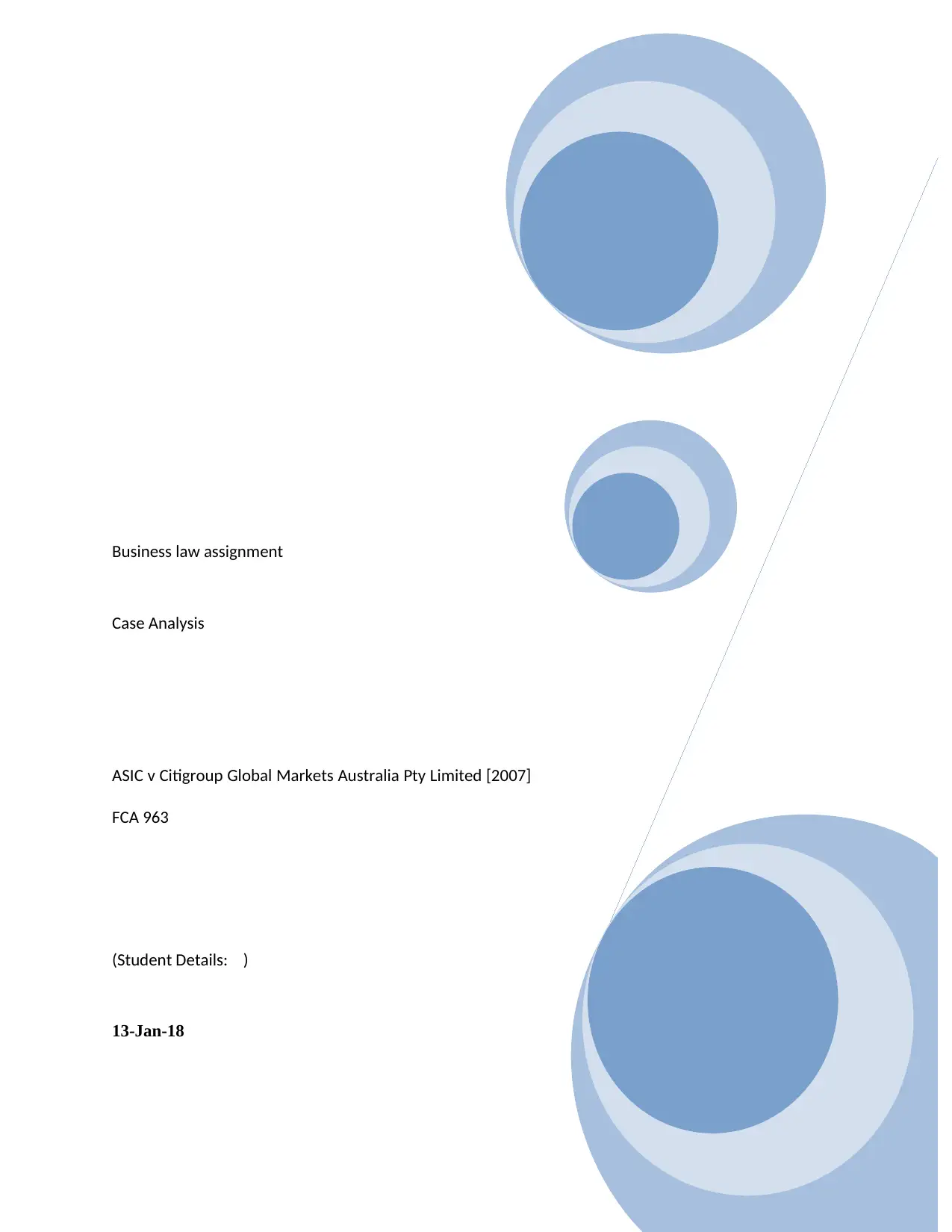
Business law assignment
Case Analysis
ASIC v Citigroup Global Markets Australia Pty Limited [2007]
FCA 963
(Student Details: )
13-Jan-18
Case Analysis
ASIC v Citigroup Global Markets Australia Pty Limited [2007]
FCA 963
(Student Details: )
13-Jan-18
Paraphrase This Document
Need a fresh take? Get an instant paraphrase of this document with our AI Paraphraser
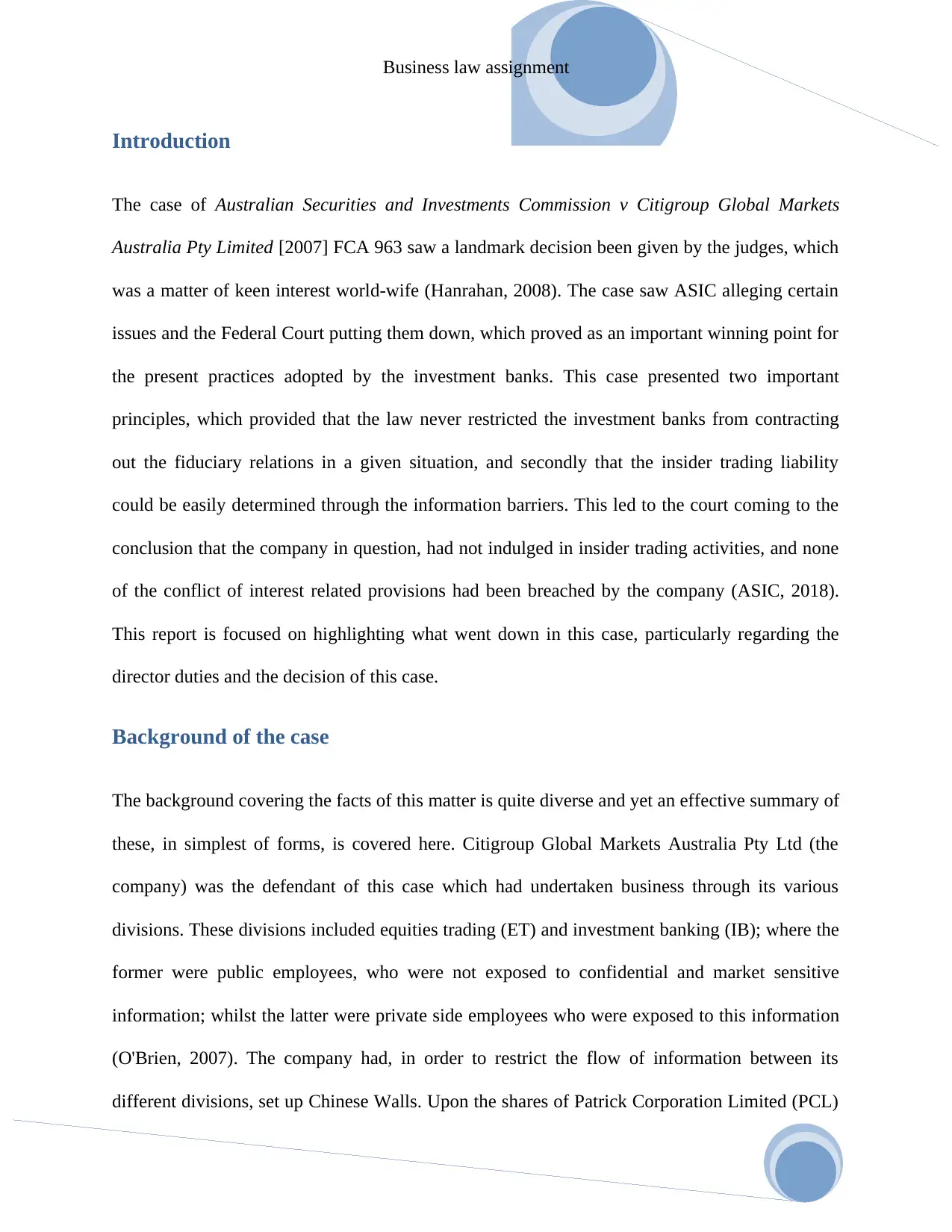
Business law assignment
Introduction
The case of Australian Securities and Investments Commission v Citigroup Global Markets
Australia Pty Limited [2007] FCA 963 saw a landmark decision been given by the judges, which
was a matter of keen interest world-wife (Hanrahan, 2008). The case saw ASIC alleging certain
issues and the Federal Court putting them down, which proved as an important winning point for
the present practices adopted by the investment banks. This case presented two important
principles, which provided that the law never restricted the investment banks from contracting
out the fiduciary relations in a given situation, and secondly that the insider trading liability
could be easily determined through the information barriers. This led to the court coming to the
conclusion that the company in question, had not indulged in insider trading activities, and none
of the conflict of interest related provisions had been breached by the company (ASIC, 2018).
This report is focused on highlighting what went down in this case, particularly regarding the
director duties and the decision of this case.
Background of the case
The background covering the facts of this matter is quite diverse and yet an effective summary of
these, in simplest of forms, is covered here. Citigroup Global Markets Australia Pty Ltd (the
company) was the defendant of this case which had undertaken business through its various
divisions. These divisions included equities trading (ET) and investment banking (IB); where the
former were public employees, who were not exposed to confidential and market sensitive
information; whilst the latter were private side employees who were exposed to this information
(O'Brien, 2007). The company had, in order to restrict the flow of information between its
different divisions, set up Chinese Walls. Upon the shares of Patrick Corporation Limited (PCL)
Introduction
The case of Australian Securities and Investments Commission v Citigroup Global Markets
Australia Pty Limited [2007] FCA 963 saw a landmark decision been given by the judges, which
was a matter of keen interest world-wife (Hanrahan, 2008). The case saw ASIC alleging certain
issues and the Federal Court putting them down, which proved as an important winning point for
the present practices adopted by the investment banks. This case presented two important
principles, which provided that the law never restricted the investment banks from contracting
out the fiduciary relations in a given situation, and secondly that the insider trading liability
could be easily determined through the information barriers. This led to the court coming to the
conclusion that the company in question, had not indulged in insider trading activities, and none
of the conflict of interest related provisions had been breached by the company (ASIC, 2018).
This report is focused on highlighting what went down in this case, particularly regarding the
director duties and the decision of this case.
Background of the case
The background covering the facts of this matter is quite diverse and yet an effective summary of
these, in simplest of forms, is covered here. Citigroup Global Markets Australia Pty Ltd (the
company) was the defendant of this case which had undertaken business through its various
divisions. These divisions included equities trading (ET) and investment banking (IB); where the
former were public employees, who were not exposed to confidential and market sensitive
information; whilst the latter were private side employees who were exposed to this information
(O'Brien, 2007). The company had, in order to restrict the flow of information between its
different divisions, set up Chinese Walls. Upon the shares of Patrick Corporation Limited (PCL)
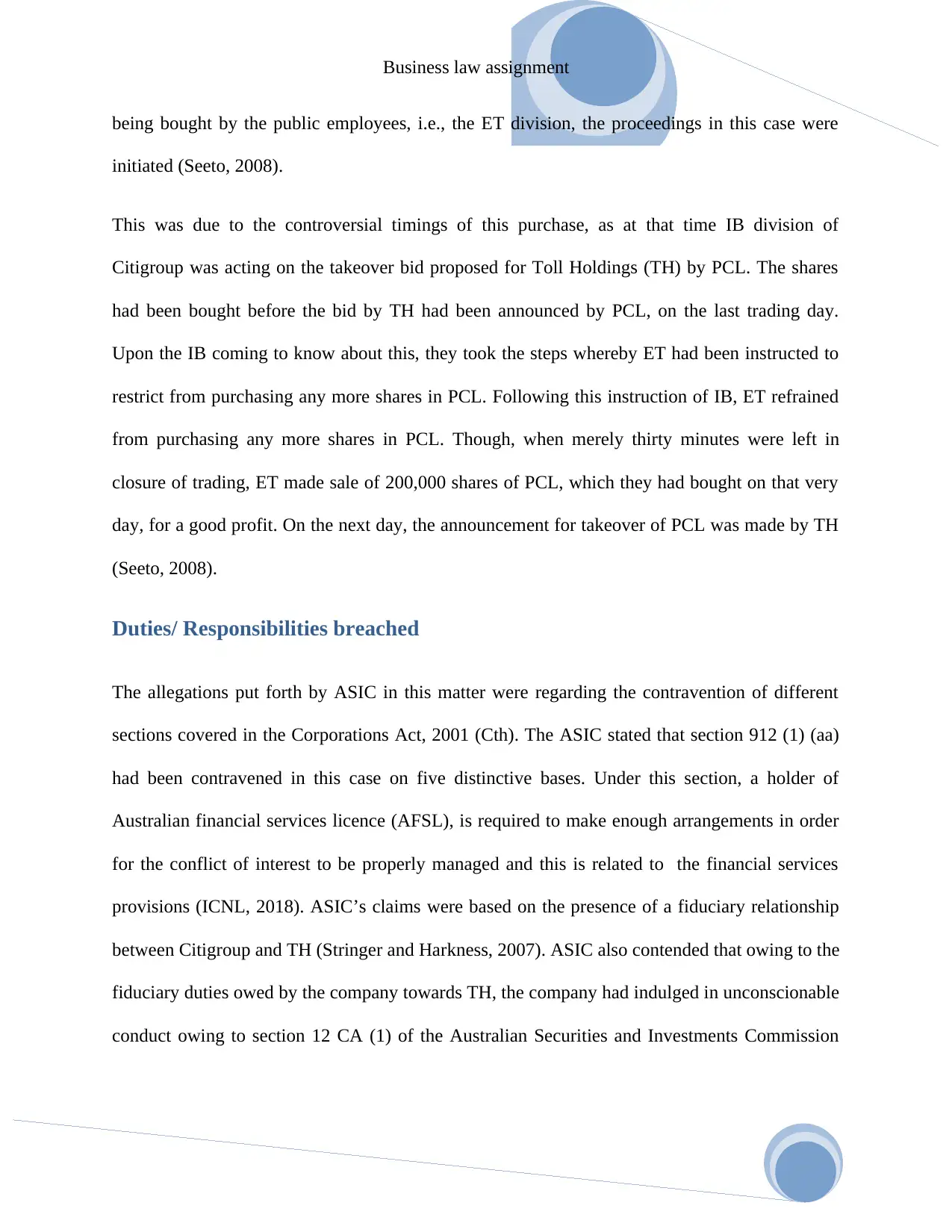
Business law assignment
being bought by the public employees, i.e., the ET division, the proceedings in this case were
initiated (Seeto, 2008).
This was due to the controversial timings of this purchase, as at that time IB division of
Citigroup was acting on the takeover bid proposed for Toll Holdings (TH) by PCL. The shares
had been bought before the bid by TH had been announced by PCL, on the last trading day.
Upon the IB coming to know about this, they took the steps whereby ET had been instructed to
restrict from purchasing any more shares in PCL. Following this instruction of IB, ET refrained
from purchasing any more shares in PCL. Though, when merely thirty minutes were left in
closure of trading, ET made sale of 200,000 shares of PCL, which they had bought on that very
day, for a good profit. On the next day, the announcement for takeover of PCL was made by TH
(Seeto, 2008).
Duties/ Responsibilities breached
The allegations put forth by ASIC in this matter were regarding the contravention of different
sections covered in the Corporations Act, 2001 (Cth). The ASIC stated that section 912 (1) (aa)
had been contravened in this case on five distinctive bases. Under this section, a holder of
Australian financial services licence (AFSL), is required to make enough arrangements in order
for the conflict of interest to be properly managed and this is related to the financial services
provisions (ICNL, 2018). ASIC’s claims were based on the presence of a fiduciary relationship
between Citigroup and TH (Stringer and Harkness, 2007). ASIC also contended that owing to the
fiduciary duties owed by the company towards TH, the company had indulged in unconscionable
conduct owing to section 12 CA (1) of the Australian Securities and Investments Commission
being bought by the public employees, i.e., the ET division, the proceedings in this case were
initiated (Seeto, 2008).
This was due to the controversial timings of this purchase, as at that time IB division of
Citigroup was acting on the takeover bid proposed for Toll Holdings (TH) by PCL. The shares
had been bought before the bid by TH had been announced by PCL, on the last trading day.
Upon the IB coming to know about this, they took the steps whereby ET had been instructed to
restrict from purchasing any more shares in PCL. Following this instruction of IB, ET refrained
from purchasing any more shares in PCL. Though, when merely thirty minutes were left in
closure of trading, ET made sale of 200,000 shares of PCL, which they had bought on that very
day, for a good profit. On the next day, the announcement for takeover of PCL was made by TH
(Seeto, 2008).
Duties/ Responsibilities breached
The allegations put forth by ASIC in this matter were regarding the contravention of different
sections covered in the Corporations Act, 2001 (Cth). The ASIC stated that section 912 (1) (aa)
had been contravened in this case on five distinctive bases. Under this section, a holder of
Australian financial services licence (AFSL), is required to make enough arrangements in order
for the conflict of interest to be properly managed and this is related to the financial services
provisions (ICNL, 2018). ASIC’s claims were based on the presence of a fiduciary relationship
between Citigroup and TH (Stringer and Harkness, 2007). ASIC also contended that owing to the
fiduciary duties owed by the company towards TH, the company had indulged in unconscionable
conduct owing to section 12 CA (1) of the Australian Securities and Investments Commission
⊘ This is a preview!⊘
Do you want full access?
Subscribe today to unlock all pages.

Trusted by 1+ million students worldwide
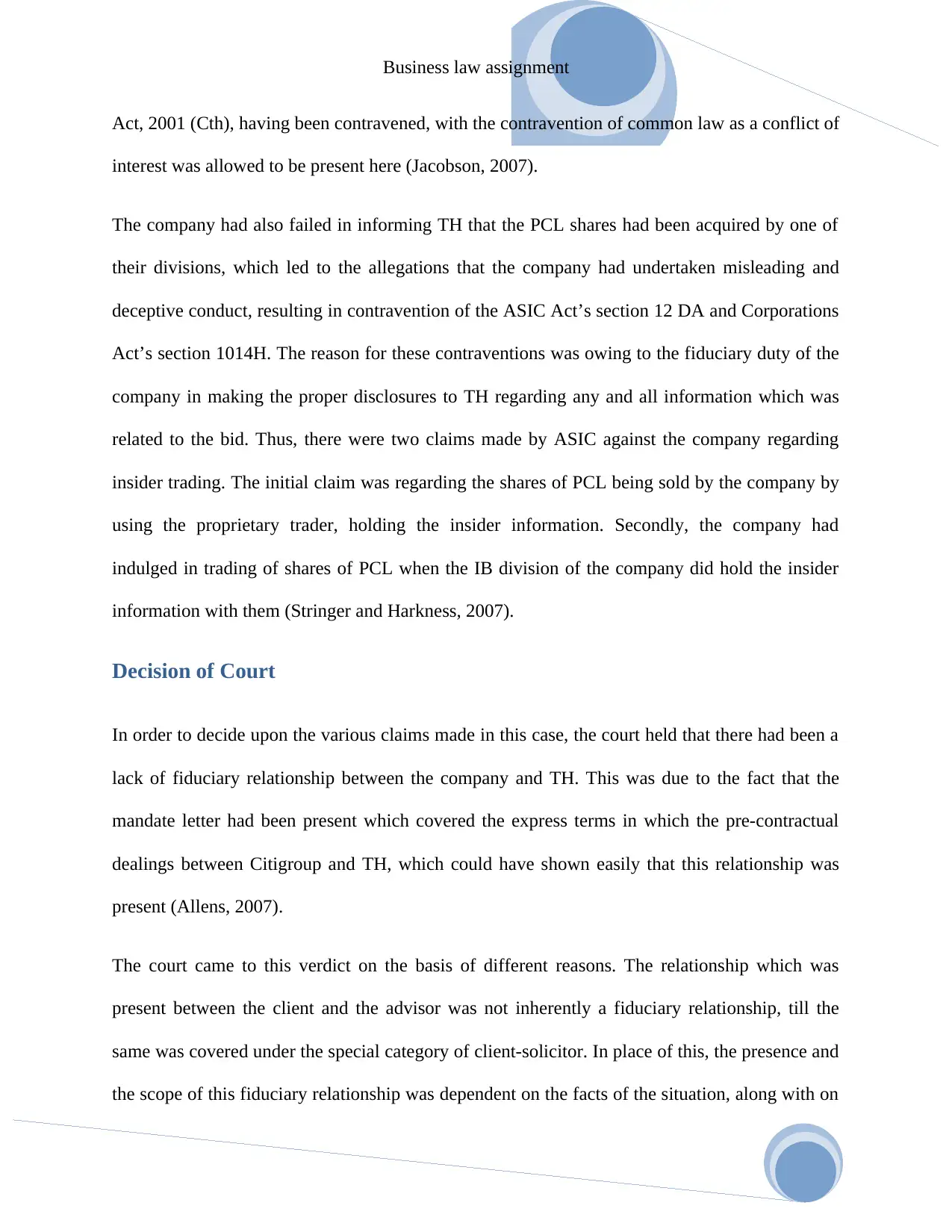
Business law assignment
Act, 2001 (Cth), having been contravened, with the contravention of common law as a conflict of
interest was allowed to be present here (Jacobson, 2007).
The company had also failed in informing TH that the PCL shares had been acquired by one of
their divisions, which led to the allegations that the company had undertaken misleading and
deceptive conduct, resulting in contravention of the ASIC Act’s section 12 DA and Corporations
Act’s section 1014H. The reason for these contraventions was owing to the fiduciary duty of the
company in making the proper disclosures to TH regarding any and all information which was
related to the bid. Thus, there were two claims made by ASIC against the company regarding
insider trading. The initial claim was regarding the shares of PCL being sold by the company by
using the proprietary trader, holding the insider information. Secondly, the company had
indulged in trading of shares of PCL when the IB division of the company did hold the insider
information with them (Stringer and Harkness, 2007).
Decision of Court
In order to decide upon the various claims made in this case, the court held that there had been a
lack of fiduciary relationship between the company and TH. This was due to the fact that the
mandate letter had been present which covered the express terms in which the pre-contractual
dealings between Citigroup and TH, which could have shown easily that this relationship was
present (Allens, 2007).
The court came to this verdict on the basis of different reasons. The relationship which was
present between the client and the advisor was not inherently a fiduciary relationship, till the
same was covered under the special category of client-solicitor. In place of this, the presence and
the scope of this fiduciary relationship was dependent on the facts of the situation, along with on
Act, 2001 (Cth), having been contravened, with the contravention of common law as a conflict of
interest was allowed to be present here (Jacobson, 2007).
The company had also failed in informing TH that the PCL shares had been acquired by one of
their divisions, which led to the allegations that the company had undertaken misleading and
deceptive conduct, resulting in contravention of the ASIC Act’s section 12 DA and Corporations
Act’s section 1014H. The reason for these contraventions was owing to the fiduciary duty of the
company in making the proper disclosures to TH regarding any and all information which was
related to the bid. Thus, there were two claims made by ASIC against the company regarding
insider trading. The initial claim was regarding the shares of PCL being sold by the company by
using the proprietary trader, holding the insider information. Secondly, the company had
indulged in trading of shares of PCL when the IB division of the company did hold the insider
information with them (Stringer and Harkness, 2007).
Decision of Court
In order to decide upon the various claims made in this case, the court held that there had been a
lack of fiduciary relationship between the company and TH. This was due to the fact that the
mandate letter had been present which covered the express terms in which the pre-contractual
dealings between Citigroup and TH, which could have shown easily that this relationship was
present (Allens, 2007).
The court came to this verdict on the basis of different reasons. The relationship which was
present between the client and the advisor was not inherently a fiduciary relationship, till the
same was covered under the special category of client-solicitor. In place of this, the presence and
the scope of this fiduciary relationship was dependent on the facts of the situation, along with on
Paraphrase This Document
Need a fresh take? Get an instant paraphrase of this document with our AI Paraphraser
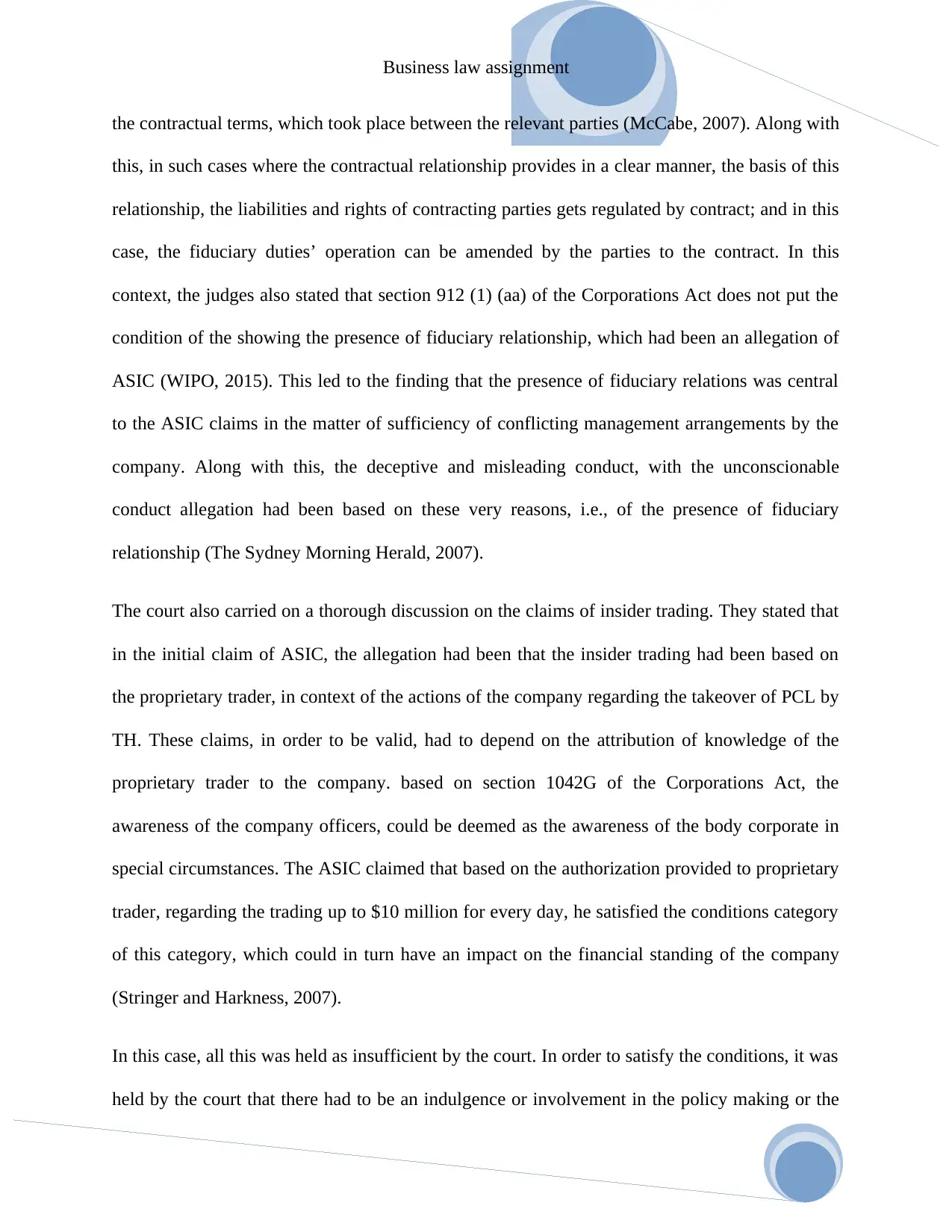
Business law assignment
the contractual terms, which took place between the relevant parties (McCabe, 2007). Along with
this, in such cases where the contractual relationship provides in a clear manner, the basis of this
relationship, the liabilities and rights of contracting parties gets regulated by contract; and in this
case, the fiduciary duties’ operation can be amended by the parties to the contract. In this
context, the judges also stated that section 912 (1) (aa) of the Corporations Act does not put the
condition of the showing the presence of fiduciary relationship, which had been an allegation of
ASIC (WIPO, 2015). This led to the finding that the presence of fiduciary relations was central
to the ASIC claims in the matter of sufficiency of conflicting management arrangements by the
company. Along with this, the deceptive and misleading conduct, with the unconscionable
conduct allegation had been based on these very reasons, i.e., of the presence of fiduciary
relationship (The Sydney Morning Herald, 2007).
The court also carried on a thorough discussion on the claims of insider trading. They stated that
in the initial claim of ASIC, the allegation had been that the insider trading had been based on
the proprietary trader, in context of the actions of the company regarding the takeover of PCL by
TH. These claims, in order to be valid, had to depend on the attribution of knowledge of the
proprietary trader to the company. based on section 1042G of the Corporations Act, the
awareness of the company officers, could be deemed as the awareness of the body corporate in
special circumstances. The ASIC claimed that based on the authorization provided to proprietary
trader, regarding the trading up to $10 million for every day, he satisfied the conditions category
of this category, which could in turn have an impact on the financial standing of the company
(Stringer and Harkness, 2007).
In this case, all this was held as insufficient by the court. In order to satisfy the conditions, it was
held by the court that there had to be an indulgence or involvement in the policy making or the
the contractual terms, which took place between the relevant parties (McCabe, 2007). Along with
this, in such cases where the contractual relationship provides in a clear manner, the basis of this
relationship, the liabilities and rights of contracting parties gets regulated by contract; and in this
case, the fiduciary duties’ operation can be amended by the parties to the contract. In this
context, the judges also stated that section 912 (1) (aa) of the Corporations Act does not put the
condition of the showing the presence of fiduciary relationship, which had been an allegation of
ASIC (WIPO, 2015). This led to the finding that the presence of fiduciary relations was central
to the ASIC claims in the matter of sufficiency of conflicting management arrangements by the
company. Along with this, the deceptive and misleading conduct, with the unconscionable
conduct allegation had been based on these very reasons, i.e., of the presence of fiduciary
relationship (The Sydney Morning Herald, 2007).
The court also carried on a thorough discussion on the claims of insider trading. They stated that
in the initial claim of ASIC, the allegation had been that the insider trading had been based on
the proprietary trader, in context of the actions of the company regarding the takeover of PCL by
TH. These claims, in order to be valid, had to depend on the attribution of knowledge of the
proprietary trader to the company. based on section 1042G of the Corporations Act, the
awareness of the company officers, could be deemed as the awareness of the body corporate in
special circumstances. The ASIC claimed that based on the authorization provided to proprietary
trader, regarding the trading up to $10 million for every day, he satisfied the conditions category
of this category, which could in turn have an impact on the financial standing of the company
(Stringer and Harkness, 2007).
In this case, all this was held as insufficient by the court. In order to satisfy the conditions, it was
held by the court that there had to be an indulgence or involvement in the policy making or the
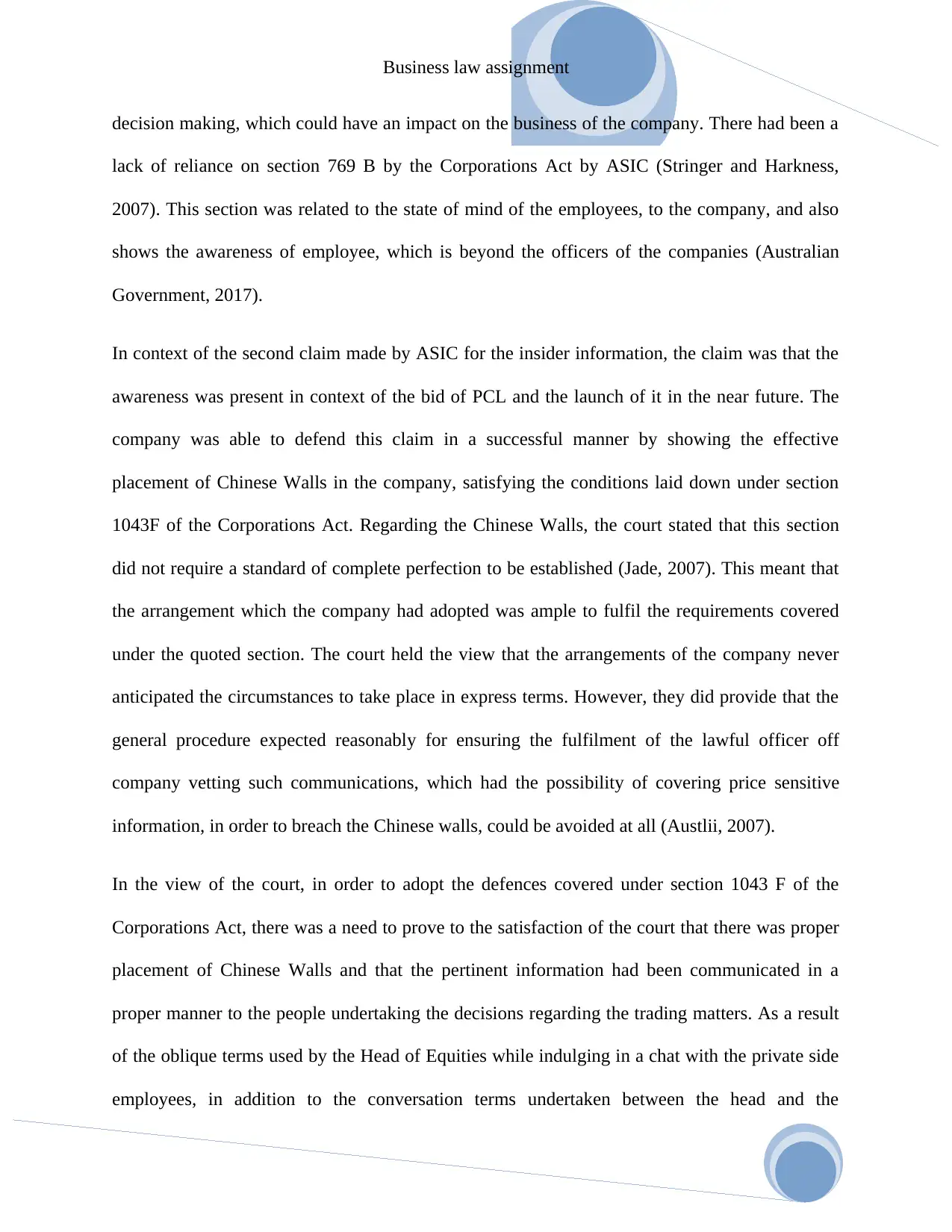
Business law assignment
decision making, which could have an impact on the business of the company. There had been a
lack of reliance on section 769 B by the Corporations Act by ASIC (Stringer and Harkness,
2007). This section was related to the state of mind of the employees, to the company, and also
shows the awareness of employee, which is beyond the officers of the companies (Australian
Government, 2017).
In context of the second claim made by ASIC for the insider information, the claim was that the
awareness was present in context of the bid of PCL and the launch of it in the near future. The
company was able to defend this claim in a successful manner by showing the effective
placement of Chinese Walls in the company, satisfying the conditions laid down under section
1043F of the Corporations Act. Regarding the Chinese Walls, the court stated that this section
did not require a standard of complete perfection to be established (Jade, 2007). This meant that
the arrangement which the company had adopted was ample to fulfil the requirements covered
under the quoted section. The court held the view that the arrangements of the company never
anticipated the circumstances to take place in express terms. However, they did provide that the
general procedure expected reasonably for ensuring the fulfilment of the lawful officer off
company vetting such communications, which had the possibility of covering price sensitive
information, in order to breach the Chinese walls, could be avoided at all (Austlii, 2007).
In the view of the court, in order to adopt the defences covered under section 1043 F of the
Corporations Act, there was a need to prove to the satisfaction of the court that there was proper
placement of Chinese Walls and that the pertinent information had been communicated in a
proper manner to the people undertaking the decisions regarding the trading matters. As a result
of the oblique terms used by the Head of Equities while indulging in a chat with the private side
employees, in addition to the conversation terms undertaken between the head and the
decision making, which could have an impact on the business of the company. There had been a
lack of reliance on section 769 B by the Corporations Act by ASIC (Stringer and Harkness,
2007). This section was related to the state of mind of the employees, to the company, and also
shows the awareness of employee, which is beyond the officers of the companies (Australian
Government, 2017).
In context of the second claim made by ASIC for the insider information, the claim was that the
awareness was present in context of the bid of PCL and the launch of it in the near future. The
company was able to defend this claim in a successful manner by showing the effective
placement of Chinese Walls in the company, satisfying the conditions laid down under section
1043F of the Corporations Act. Regarding the Chinese Walls, the court stated that this section
did not require a standard of complete perfection to be established (Jade, 2007). This meant that
the arrangement which the company had adopted was ample to fulfil the requirements covered
under the quoted section. The court held the view that the arrangements of the company never
anticipated the circumstances to take place in express terms. However, they did provide that the
general procedure expected reasonably for ensuring the fulfilment of the lawful officer off
company vetting such communications, which had the possibility of covering price sensitive
information, in order to breach the Chinese walls, could be avoided at all (Austlii, 2007).
In the view of the court, in order to adopt the defences covered under section 1043 F of the
Corporations Act, there was a need to prove to the satisfaction of the court that there was proper
placement of Chinese Walls and that the pertinent information had been communicated in a
proper manner to the people undertaking the decisions regarding the trading matters. As a result
of the oblique terms used by the Head of Equities while indulging in a chat with the private side
employees, in addition to the conversation terms undertaken between the head and the
⊘ This is a preview!⊘
Do you want full access?
Subscribe today to unlock all pages.

Trusted by 1+ million students worldwide
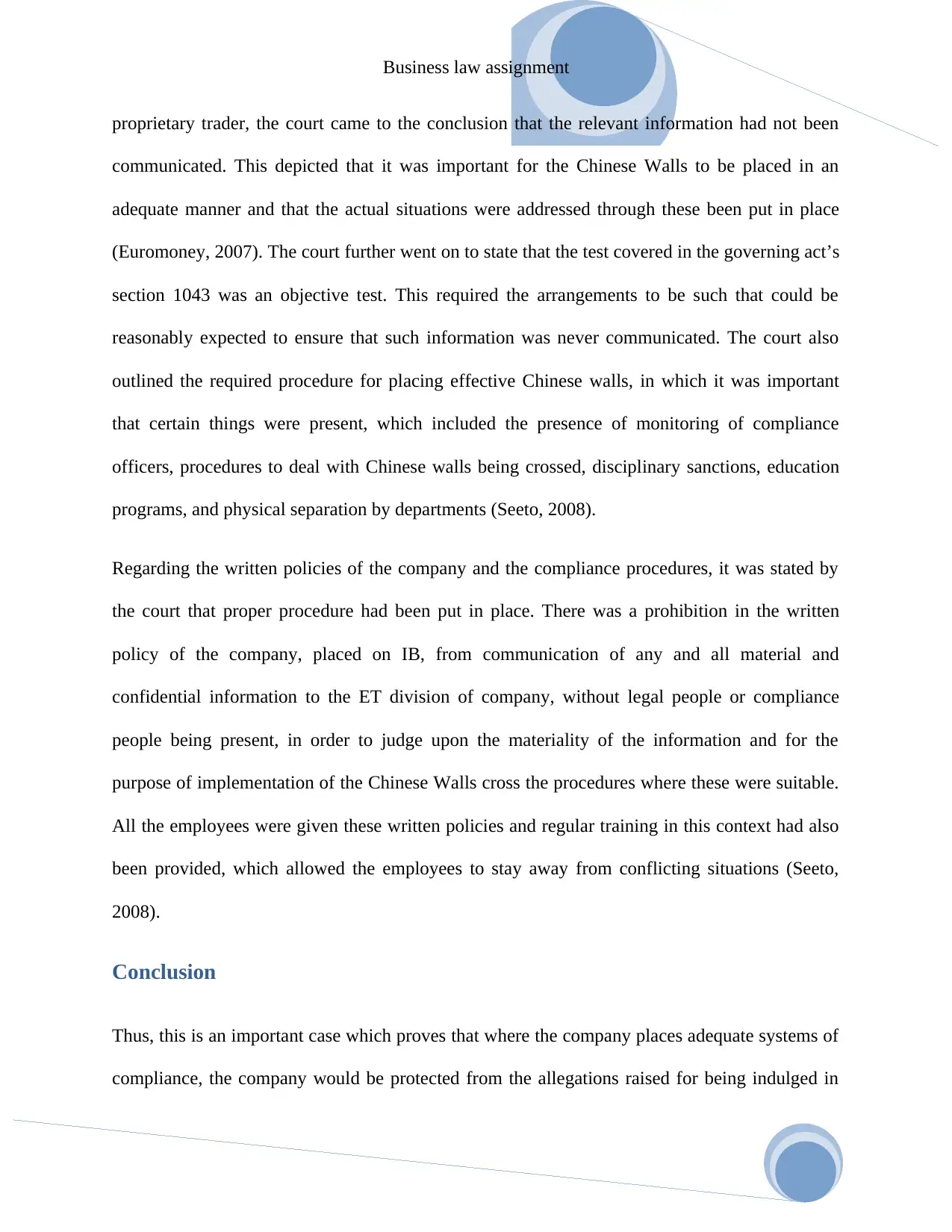
Business law assignment
proprietary trader, the court came to the conclusion that the relevant information had not been
communicated. This depicted that it was important for the Chinese Walls to be placed in an
adequate manner and that the actual situations were addressed through these been put in place
(Euromoney, 2007). The court further went on to state that the test covered in the governing act’s
section 1043 was an objective test. This required the arrangements to be such that could be
reasonably expected to ensure that such information was never communicated. The court also
outlined the required procedure for placing effective Chinese walls, in which it was important
that certain things were present, which included the presence of monitoring of compliance
officers, procedures to deal with Chinese walls being crossed, disciplinary sanctions, education
programs, and physical separation by departments (Seeto, 2008).
Regarding the written policies of the company and the compliance procedures, it was stated by
the court that proper procedure had been put in place. There was a prohibition in the written
policy of the company, placed on IB, from communication of any and all material and
confidential information to the ET division of company, without legal people or compliance
people being present, in order to judge upon the materiality of the information and for the
purpose of implementation of the Chinese Walls cross the procedures where these were suitable.
All the employees were given these written policies and regular training in this context had also
been provided, which allowed the employees to stay away from conflicting situations (Seeto,
2008).
Conclusion
Thus, this is an important case which proves that where the company places adequate systems of
compliance, the company would be protected from the allegations raised for being indulged in
proprietary trader, the court came to the conclusion that the relevant information had not been
communicated. This depicted that it was important for the Chinese Walls to be placed in an
adequate manner and that the actual situations were addressed through these been put in place
(Euromoney, 2007). The court further went on to state that the test covered in the governing act’s
section 1043 was an objective test. This required the arrangements to be such that could be
reasonably expected to ensure that such information was never communicated. The court also
outlined the required procedure for placing effective Chinese walls, in which it was important
that certain things were present, which included the presence of monitoring of compliance
officers, procedures to deal with Chinese walls being crossed, disciplinary sanctions, education
programs, and physical separation by departments (Seeto, 2008).
Regarding the written policies of the company and the compliance procedures, it was stated by
the court that proper procedure had been put in place. There was a prohibition in the written
policy of the company, placed on IB, from communication of any and all material and
confidential information to the ET division of company, without legal people or compliance
people being present, in order to judge upon the materiality of the information and for the
purpose of implementation of the Chinese Walls cross the procedures where these were suitable.
All the employees were given these written policies and regular training in this context had also
been provided, which allowed the employees to stay away from conflicting situations (Seeto,
2008).
Conclusion
Thus, this is an important case which proves that where the company places adequate systems of
compliance, the company would be protected from the allegations raised for being indulged in
Paraphrase This Document
Need a fresh take? Get an instant paraphrase of this document with our AI Paraphraser
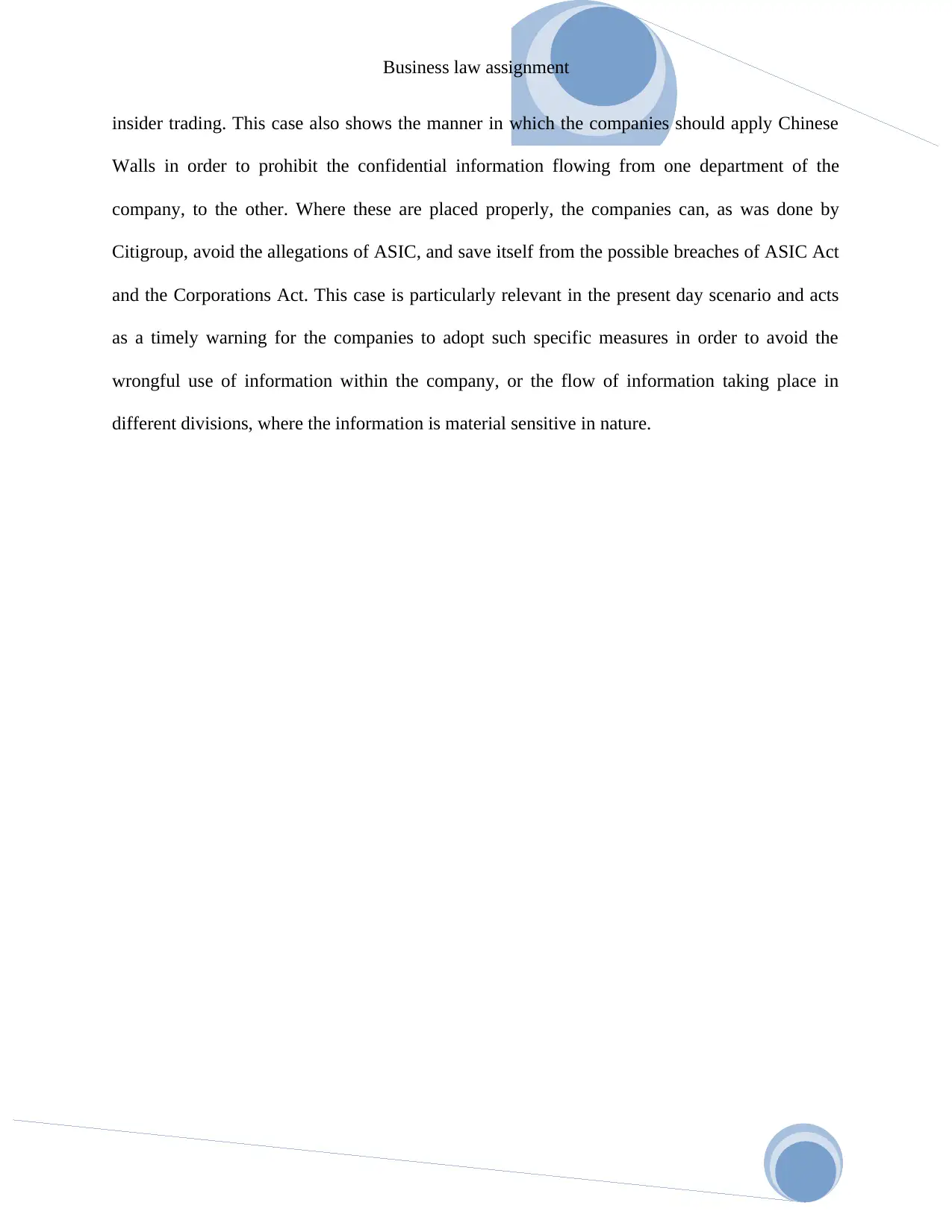
Business law assignment
insider trading. This case also shows the manner in which the companies should apply Chinese
Walls in order to prohibit the confidential information flowing from one department of the
company, to the other. Where these are placed properly, the companies can, as was done by
Citigroup, avoid the allegations of ASIC, and save itself from the possible breaches of ASIC Act
and the Corporations Act. This case is particularly relevant in the present day scenario and acts
as a timely warning for the companies to adopt such specific measures in order to avoid the
wrongful use of information within the company, or the flow of information taking place in
different divisions, where the information is material sensitive in nature.
insider trading. This case also shows the manner in which the companies should apply Chinese
Walls in order to prohibit the confidential information flowing from one department of the
company, to the other. Where these are placed properly, the companies can, as was done by
Citigroup, avoid the allegations of ASIC, and save itself from the possible breaches of ASIC Act
and the Corporations Act. This case is particularly relevant in the present day scenario and acts
as a timely warning for the companies to adopt such specific measures in order to avoid the
wrongful use of information within the company, or the flow of information taking place in
different divisions, where the information is material sensitive in nature.
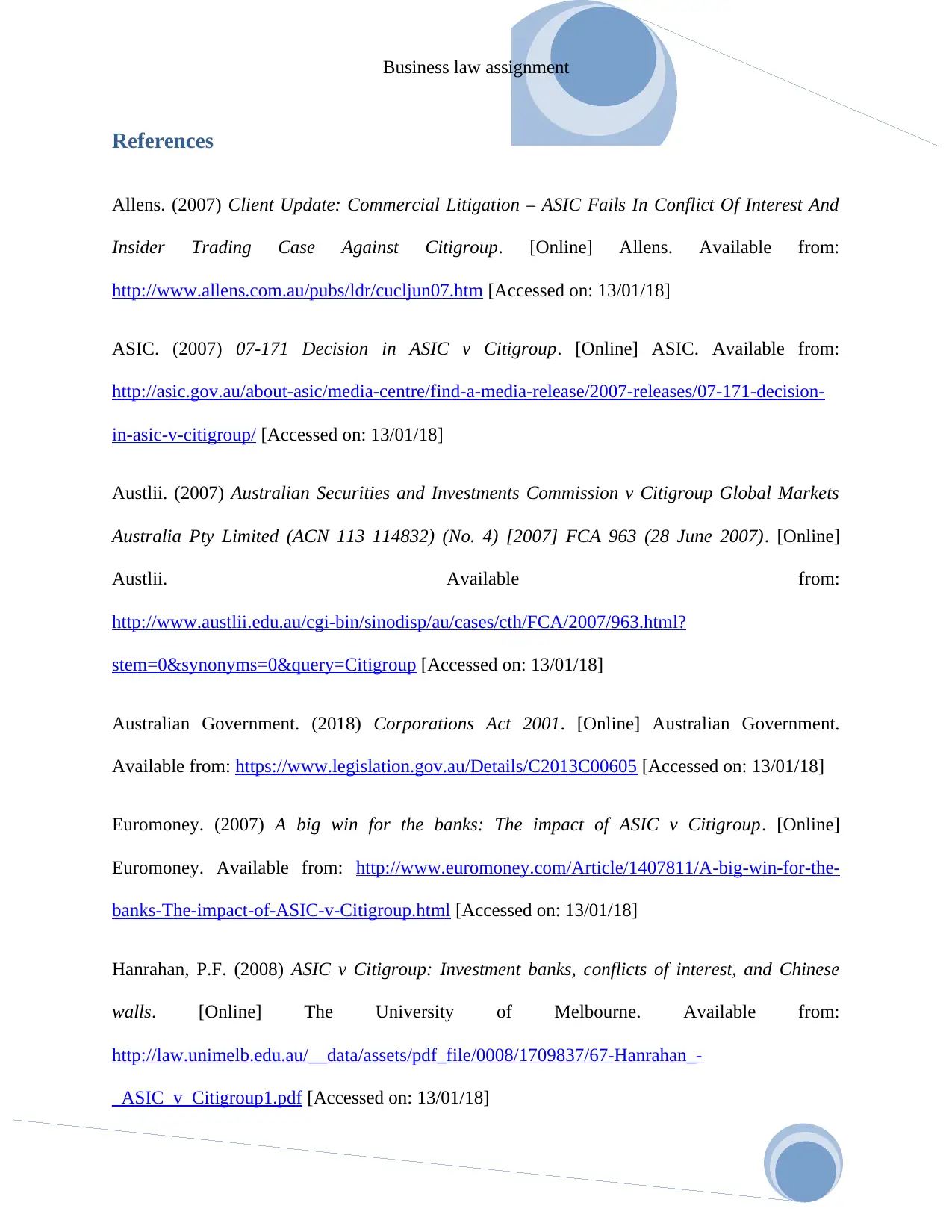
Business law assignment
References
Allens. (2007) Client Update: Commercial Litigation – ASIC Fails In Conflict Of Interest And
Insider Trading Case Against Citigroup. [Online] Allens. Available from:
http://www.allens.com.au/pubs/ldr/cucljun07.htm [Accessed on: 13/01/18]
ASIC. (2007) 07-171 Decision in ASIC v Citigroup. [Online] ASIC. Available from:
http://asic.gov.au/about-asic/media-centre/find-a-media-release/2007-releases/07-171-decision-
in-asic-v-citigroup/ [Accessed on: 13/01/18]
Austlii. (2007) Australian Securities and Investments Commission v Citigroup Global Markets
Australia Pty Limited (ACN 113 114832) (No. 4) [2007] FCA 963 (28 June 2007). [Online]
Austlii. Available from:
http://www.austlii.edu.au/cgi-bin/sinodisp/au/cases/cth/FCA/2007/963.html?
stem=0&synonyms=0&query=Citigroup [Accessed on: 13/01/18]
Australian Government. (2018) Corporations Act 2001. [Online] Australian Government.
Available from: https://www.legislation.gov.au/Details/C2013C00605 [Accessed on: 13/01/18]
Euromoney. (2007) A big win for the banks: The impact of ASIC v Citigroup. [Online]
Euromoney. Available from: http://www.euromoney.com/Article/1407811/A-big-win-for-the-
banks-The-impact-of-ASIC-v-Citigroup.html [Accessed on: 13/01/18]
Hanrahan, P.F. (2008) ASIC v Citigroup: Investment banks, conflicts of interest, and Chinese
walls. [Online] The University of Melbourne. Available from:
http://law.unimelb.edu.au/__data/assets/pdf_file/0008/1709837/67-Hanrahan_-
_ASIC_v_Citigroup1.pdf [Accessed on: 13/01/18]
References
Allens. (2007) Client Update: Commercial Litigation – ASIC Fails In Conflict Of Interest And
Insider Trading Case Against Citigroup. [Online] Allens. Available from:
http://www.allens.com.au/pubs/ldr/cucljun07.htm [Accessed on: 13/01/18]
ASIC. (2007) 07-171 Decision in ASIC v Citigroup. [Online] ASIC. Available from:
http://asic.gov.au/about-asic/media-centre/find-a-media-release/2007-releases/07-171-decision-
in-asic-v-citigroup/ [Accessed on: 13/01/18]
Austlii. (2007) Australian Securities and Investments Commission v Citigroup Global Markets
Australia Pty Limited (ACN 113 114832) (No. 4) [2007] FCA 963 (28 June 2007). [Online]
Austlii. Available from:
http://www.austlii.edu.au/cgi-bin/sinodisp/au/cases/cth/FCA/2007/963.html?
stem=0&synonyms=0&query=Citigroup [Accessed on: 13/01/18]
Australian Government. (2018) Corporations Act 2001. [Online] Australian Government.
Available from: https://www.legislation.gov.au/Details/C2013C00605 [Accessed on: 13/01/18]
Euromoney. (2007) A big win for the banks: The impact of ASIC v Citigroup. [Online]
Euromoney. Available from: http://www.euromoney.com/Article/1407811/A-big-win-for-the-
banks-The-impact-of-ASIC-v-Citigroup.html [Accessed on: 13/01/18]
Hanrahan, P.F. (2008) ASIC v Citigroup: Investment banks, conflicts of interest, and Chinese
walls. [Online] The University of Melbourne. Available from:
http://law.unimelb.edu.au/__data/assets/pdf_file/0008/1709837/67-Hanrahan_-
_ASIC_v_Citigroup1.pdf [Accessed on: 13/01/18]
⊘ This is a preview!⊘
Do you want full access?
Subscribe today to unlock all pages.

Trusted by 1+ million students worldwide
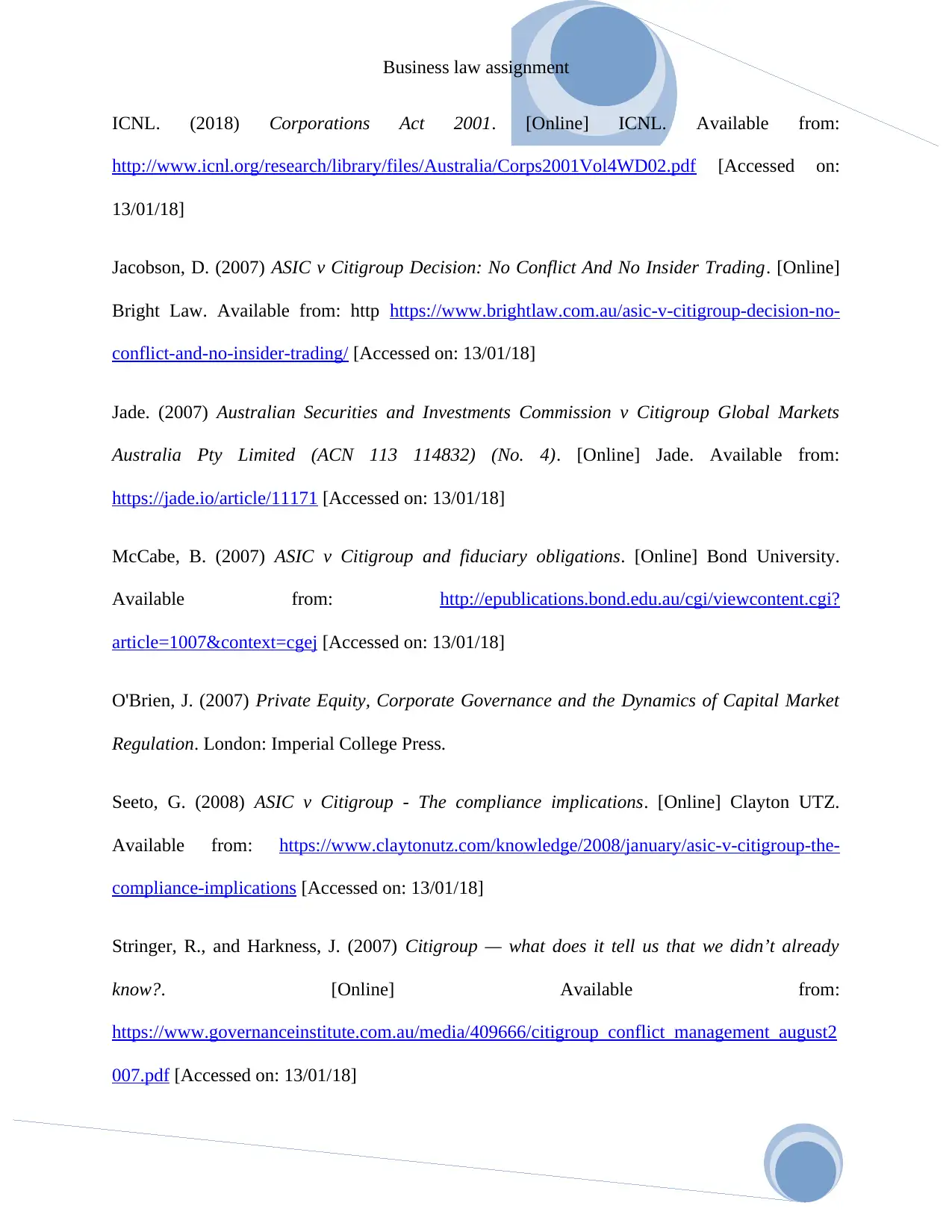
Business law assignment
ICNL. (2018) Corporations Act 2001. [Online] ICNL. Available from:
http://www.icnl.org/research/library/files/Australia/Corps2001Vol4WD02.pdf [Accessed on:
13/01/18]
Jacobson, D. (2007) ASIC v Citigroup Decision: No Conflict And No Insider Trading. [Online]
Bright Law. Available from: http https://www.brightlaw.com.au/asic-v-citigroup-decision-no-
conflict-and-no-insider-trading/ [Accessed on: 13/01/18]
Jade. (2007) Australian Securities and Investments Commission v Citigroup Global Markets
Australia Pty Limited (ACN 113 114832) (No. 4). [Online] Jade. Available from:
https://jade.io/article/11171 [Accessed on: 13/01/18]
McCabe, B. (2007) ASIC v Citigroup and fiduciary obligations. [Online] Bond University.
Available from: http://epublications.bond.edu.au/cgi/viewcontent.cgi?
article=1007&context=cgej [Accessed on: 13/01/18]
O'Brien, J. (2007) Private Equity, Corporate Governance and the Dynamics of Capital Market
Regulation. London: Imperial College Press.
Seeto, G. (2008) ASIC v Citigroup - The compliance implications. [Online] Clayton UTZ.
Available from: https://www.claytonutz.com/knowledge/2008/january/asic-v-citigroup-the-
compliance-implications [Accessed on: 13/01/18]
Stringer, R., and Harkness, J. (2007) Citigroup — what does it tell us that we didn’t already
know?. [Online] Available from:
https://www.governanceinstitute.com.au/media/409666/citigroup_conflict_management_august2
007.pdf [Accessed on: 13/01/18]
ICNL. (2018) Corporations Act 2001. [Online] ICNL. Available from:
http://www.icnl.org/research/library/files/Australia/Corps2001Vol4WD02.pdf [Accessed on:
13/01/18]
Jacobson, D. (2007) ASIC v Citigroup Decision: No Conflict And No Insider Trading. [Online]
Bright Law. Available from: http https://www.brightlaw.com.au/asic-v-citigroup-decision-no-
conflict-and-no-insider-trading/ [Accessed on: 13/01/18]
Jade. (2007) Australian Securities and Investments Commission v Citigroup Global Markets
Australia Pty Limited (ACN 113 114832) (No. 4). [Online] Jade. Available from:
https://jade.io/article/11171 [Accessed on: 13/01/18]
McCabe, B. (2007) ASIC v Citigroup and fiduciary obligations. [Online] Bond University.
Available from: http://epublications.bond.edu.au/cgi/viewcontent.cgi?
article=1007&context=cgej [Accessed on: 13/01/18]
O'Brien, J. (2007) Private Equity, Corporate Governance and the Dynamics of Capital Market
Regulation. London: Imperial College Press.
Seeto, G. (2008) ASIC v Citigroup - The compliance implications. [Online] Clayton UTZ.
Available from: https://www.claytonutz.com/knowledge/2008/january/asic-v-citigroup-the-
compliance-implications [Accessed on: 13/01/18]
Stringer, R., and Harkness, J. (2007) Citigroup — what does it tell us that we didn’t already
know?. [Online] Available from:
https://www.governanceinstitute.com.au/media/409666/citigroup_conflict_management_august2
007.pdf [Accessed on: 13/01/18]
Paraphrase This Document
Need a fresh take? Get an instant paraphrase of this document with our AI Paraphraser
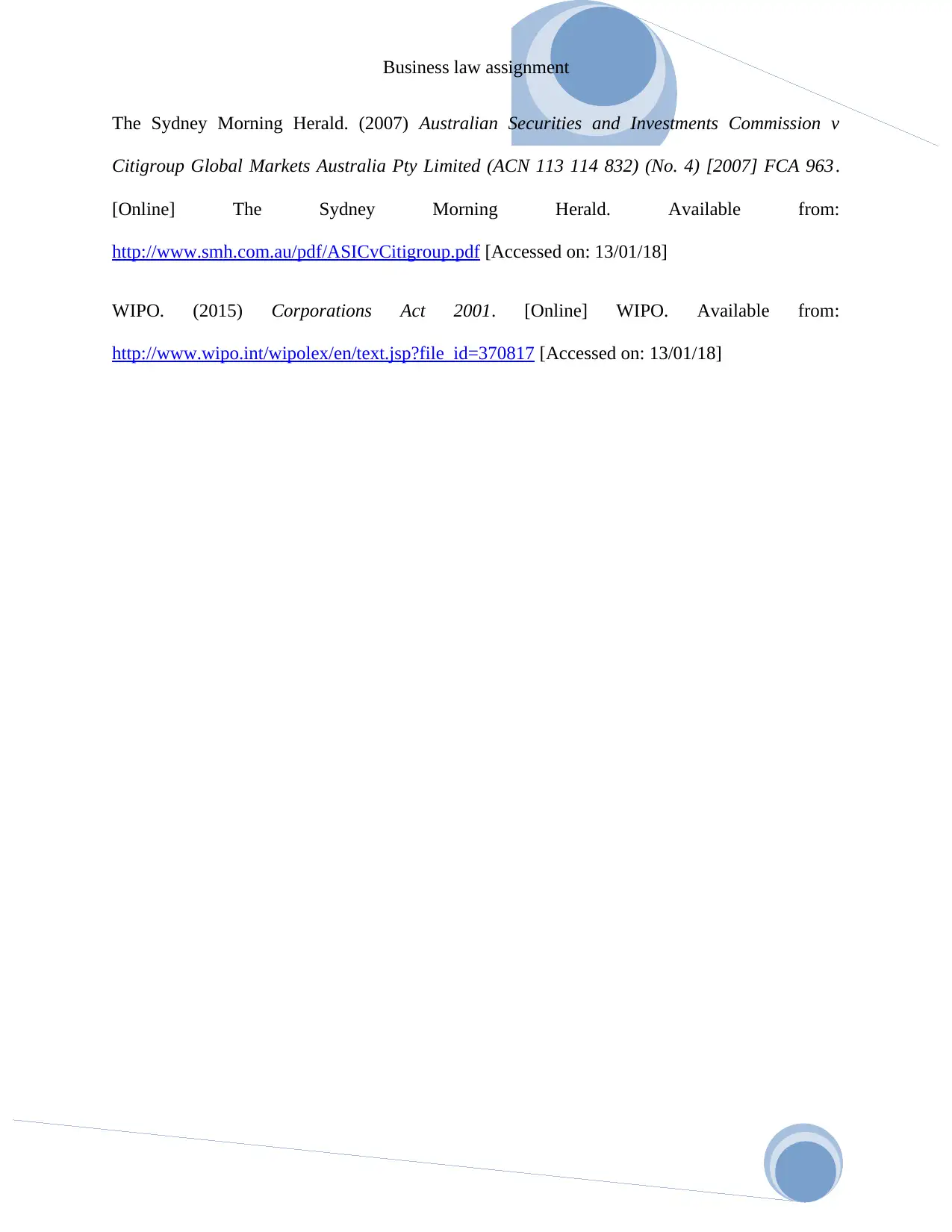
Business law assignment
The Sydney Morning Herald. (2007) Australian Securities and Investments Commission v
Citigroup Global Markets Australia Pty Limited (ACN 113 114 832) (No. 4) [2007] FCA 963.
[Online] The Sydney Morning Herald. Available from:
http://www.smh.com.au/pdf/ASICvCitigroup.pdf [Accessed on: 13/01/18]
WIPO. (2015) Corporations Act 2001. [Online] WIPO. Available from:
http://www.wipo.int/wipolex/en/text.jsp?file_id=370817 [Accessed on: 13/01/18]
The Sydney Morning Herald. (2007) Australian Securities and Investments Commission v
Citigroup Global Markets Australia Pty Limited (ACN 113 114 832) (No. 4) [2007] FCA 963.
[Online] The Sydney Morning Herald. Available from:
http://www.smh.com.au/pdf/ASICvCitigroup.pdf [Accessed on: 13/01/18]
WIPO. (2015) Corporations Act 2001. [Online] WIPO. Available from:
http://www.wipo.int/wipolex/en/text.jsp?file_id=370817 [Accessed on: 13/01/18]
1 out of 11
Your All-in-One AI-Powered Toolkit for Academic Success.
+13062052269
info@desklib.com
Available 24*7 on WhatsApp / Email
![[object Object]](/_next/static/media/star-bottom.7253800d.svg)
Unlock your academic potential
Copyright © 2020–2025 A2Z Services. All Rights Reserved. Developed and managed by ZUCOL.
